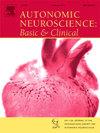颈动脉化学受体抑制可改善颈动脉化学敏感性升高参与者的运动耐受性:一项次要分析
IF 3.3
4区 医学
Q2 NEUROSCIENCES
引用次数: 0
摘要
原理 慢性心力衰竭(CHF)和慢性阻塞性肺病(COPD)的特点是颈动脉化学感受器(CC)敏感性增高和运动耐受性差。我们测试了这样一个假设:CC 敏感性升高的参与者在使用 CC 抑制剂后,运动耐受性会得到最大改善,这是因为血管传导性增加,通气要求降低,呼吸困难和腿部不适减轻。评估包括肺功能、增量心肺运动测试和基础 CC 敏感性评估。高CC敏感性被定义为阶跃性缺氧通气反应(HVR)或瞬时HVR高于健康对照组平均值一个标准差以上。结果 在 33 名成人中,17 人被归类为正常 HVR(11 名对照组/3 名慢性阻塞性肺病患者/3 名慢性阻塞性肺病患者),16 人被归类为高 HVR(1 名对照组/7 名慢性阻塞性肺病患者/8 名慢性阻塞性肺病患者)。高 HVR 参与者在多巴胺的诱导下,EET 显著改善(pinteraction = 0.011),4 分钟等时腿部不适感减轻(pinteraction = 0.024)。结论多巴胺对高 HVR 参与者的多巴胺抑制与 EET 的改善有关。这些研究结果表明,高 HVR 与运动受限有关,而 EET 的改善与 CC 介导的血管传导和腿部不适的增加有关。本文章由计算机程序翻译,如有差异,请以英文原文为准。
Carotid chemoreceptor inhibition improves exercise tolerance in participants with elevated carotid chemosensitivity: A secondary analysis
Rationale
Chronic heart failure (CHF) and chronic obstructive pulmonary disease (COPD) are characterized by exaggerated carotid chemoreceptor (CC) sensitivity and exercise intolerance. We tested the hypothesis that participants with elevated CC sensitivity would have the greatest improvement in exercise tolerance with CC inhibition, secondary to increased vascular conductance, and lower ventilatory requirements, dyspnea and leg discomfort.
Methods
Data from healthy controls, and patients with CHF or COPD were included in this secondary analysis of results from 2 randomized placebo-controlled double-blind crossover trials. Assessments included pulmonary function, incremental cardiopulmonary exercise test, and basal CC sensitivity assessment. High CC sensitivity was defined as either a stepwise hypoxic ventilatory response (HVR) or transient HVR greater than one SD above the mean in healthy controls. Participants received 2 μg/kg/min dopamine or placebo infusions (randomized) during 2 separate constant work-rate exercise tests to examine exercise endurance time (EET) and cardiopulmonary responses.
Results
Among 33 adults, 17 were categorized to normal HVR (11 controls/3 COPD/3 CHF), and 16 to high HVR (1 control/7 COPD/8 CHF). Participants with high HVR experienced significant dopamine-induced improvements in EET (pinteraction = 0.011), and reduced leg discomfort at the 4-min isotime (pinteraction = 0.024). Those with improved vascular conductance and leg discomfort had the greatest improvements in EET (p = 0.042 and p = 0.021, respectively).
Conclusions
CC inhibition with dopamine in participants with high HVR was associated with improvement in EET. These findings suggest that high HVR is related to exercise limitation, and that improvement in EET is associated with a CC-mediated increase in vascular conductance and leg discomfort.
求助全文
通过发布文献求助,成功后即可免费获取论文全文。
去求助
来源期刊
CiteScore
5.80
自引率
7.40%
发文量
83
审稿时长
66 days
期刊介绍:
This is an international journal with broad coverage of all aspects of the autonomic nervous system in man and animals. The main areas of interest include the innervation of blood vessels and viscera, autonomic ganglia, efferent and afferent autonomic pathways, and autonomic nuclei and pathways in the central nervous system.
The Editors will consider papers that deal with any aspect of the autonomic nervous system, including structure, physiology, pharmacology, biochemistry, development, evolution, ageing, behavioural aspects, integrative role and influence on emotional and physical states of the body. Interdisciplinary studies will be encouraged. Studies dealing with human pathology will be also welcome.

 求助内容:
求助内容: 应助结果提醒方式:
应助结果提醒方式:


